Bell’s new SRT Flip-up helmet offers lightweight construction plus race-tuned aerodynamics. This innovative flip-up caught my attention, but how well does it really work across varied riding scenarios?
In this Bell SRT Modular Helmet review, we will look into the SRT’s sporty design and look into how it translates into a helmet you can use every day.
However, the main question I will answer in this review is: Is this the best modular motorcycle helmet for you? Let’s find out!
Bell SRT Modular

Our Bell SRT Flip-up Final Verdict
I’ve been impressed with the Bell SRT Flip-up helmet as a versatile and feature-packed option at a competitive price point.
The fiberglass composite shell feels sturdy and well-made, and the flip-up chin bar operates smoothly with a secure locking mechanism.
I appreciate the Panovision face shield’s wide field of view and the drop-down sun visor for dealing with glare.
Ventilation is decent, with a single crown vent, two brow vents, and a large chin vent providing airflow.
It’s not the breeziest helmet I’ve worn, but it keeps me reasonably cool in moderate temperatures. The removable, washable comfort liner is plush and moisture-wicking, making it comfortable for all-day rides.
I really like the SRT’s compatibility with Sena and Cardo Bluetooth communicators. The integrated speaker pockets and ample interior space make installation a breeze. Audio quality is clear, although wind noise can be an issue at higher speeds.
After using the SRT Flip-up for several months, I’ve found it to be a dependable and practical choice for commuting, touring, and weekend adventures.
It may not have all the premium bells and whistles of more expensive modular helmets, but it covers all the basics and then some at a price that’s hard to beat.
However, there are a few potential drawbacks to consider. Wind noise is more noticeable than some quieter flip-up helmets, especially at highway speeds. The ventilation, while adequate, may leave you wanting more airflow in hot weather.
While the SRT Modular is DOT and ECE certified, it lacks the additional Snell certification that some riders prioritize.
Prices on the Bell SRT Modular can vary, so it’s worth checking Revzilla.com for the latest deals and any special offers before buying elsewhere.
If you found this review helpful, please consider liking and sharing the article. It helps Google recognize the page’s value and allows others to discover this information more easily. Thanks for your support!
Comparison To Other Models
| Model Name & Link | Key Features |
|---|---|
| Shoei Neotec 2 | Aerodynamic shell design, Pinlock Evo lens, multi-density EPS liner, micro ratchet chinstrap, integrated sun shield, eyewear compatible interior |
| Schuberth C4 Pro | Lightweight fiberglass shell, built-in antenna, micro-lock ratchet strap, large reflective panels, integrated sun visor, pre-installed speaker and microphone |
| HJC RPHA 90S Carbon | Premium carbon fiber shell, multi-density EPS, anti-bacterial interior, eyeglasses friendly, drop-down sun visor, advanced channeling ventilation system |
| Schuberth E1 Adventure | Modular adventure helmet, adjustable peak, large face shield, built-in antenna, micro-lock ratchet strap, integrated sun visor, anti-roll-off system |
The Bell SRT, while a solid performer, differs from these premium modular helmets in a few key areas:
- Shell Material: The SRT uses a fiberglass composite shell, while the Schuberth C4 Pro and E1 use fiberglass, and the HJC RPHA 90S has a carbon fiber shell. The Shoei Neotec 2’s shell material is not specified.
- Safety Ratings: The SRT Flip-up hasn’t been SHARP-rated yet, while the others have received high safety ratings.
- Noise Reduction: The SRT is noisier than the Schuberth and Shoei helmets, which are known for their quiet rides.
- Pricing: At around $350, the SRT is significantly less expensive than the others which range from $560-$830.
So, while the SRT may not have all the premium features and materials of these top-tier flip up helmets, it offers good value and solid all-around performance at a much lower price point.
The ideal customer prioritizes bang for the buck over having the absolute cutting edge in technology and refinement.
Bell SRT Helmet Riding Experience
My first impressions upon donning the Bell SRT were positive. The intermediate oval shell accommodates the natural shape of my head nicely without undue hotspots.
Cheek pads are understandably thicker than a full-face to allow chin bar movement, but they avoid excess bulk.
At speed, the SRT remains well-balanced and resistant to turbulence. A rear spoiler adds to high-speed stability.
Noise levels are lower than anticipated, too – while the SRT isn’t whisper quiet, it’s significantly dampened for such an aerodynamic lid. The design minimizes pressure points around the bottom rim as well.
The chin curtain and neck roll form an effective seal, preventing noisy air intrusion. Ventilation is excellent, thanks to the chin and crown intake vents.
Air circulates freely without excessive buffeting. The climate is easy to regulate across varying temperatures or riding intensities.
Bluetooth headset integration is simplified by recesses in the EPS foam lining to tuck speakers. I had no dramas pairing my Sena 30K unit. The shape avoids any pressure points with prolonged use as well.
Overview
The Bell SRT is a brand new modular helmet (1), taking the best elements of Bell’s race-oriented lids and incorporating them into an innovative flip-up design.
It’s available in matte black, white, and silver base colors, along with some eye-catching graphics. Expect to pay around $350, putting it firmly in the mid-range flip up segment.
So, who is this helmet aimed at? While modulars traditionally skew towards touring and commuting duties, the SRT brings a healthy dose of sport bike DNA into the equation. Riders seeking versatility paired with aggressive good looks should shortlist it.
Bell is targeting the sweet spot between the budget Bell Revolver and premium race-bred lids like Shoei’s Neotec 2. An intriguing middle ground.
But does the SRT deliver on its lofty promises? Let’s examine the details.
Construction & Materials
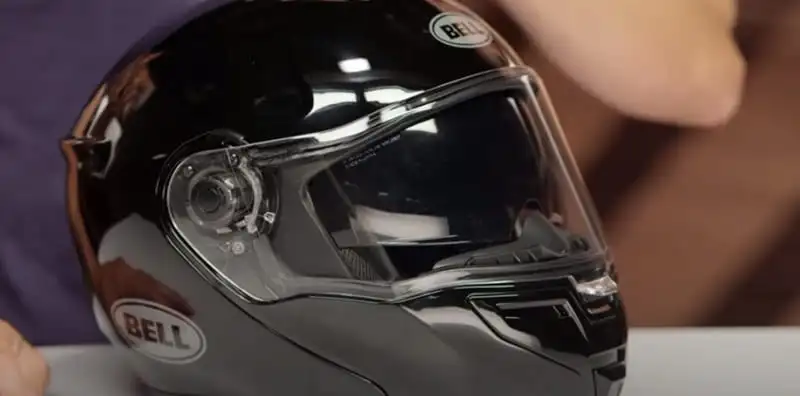
The SRT employs a fiberglass composite shell rather than the polycarbonate used on cheaper lids.
The upside is reduced weight – it tips the scales at 3 lbs 14oz, which is impressive for a flip-up, providing real estate for the pivoting chin bar and face shield.
Rider safety is enhanced, too. Fiberglass composites allow flexible energy absorption to dissipate impact forces. Coupled with a dual-density EPS liner, it is lightweight but protective.
Bell’s racing pedigree clearly informs the aerodynamic profile. Swept-back lines and edgy contours give it a sportbike style.
Great for upright sport touring or tucked-in canyon carving. The peak accommodates a wide range of head positions.
Ventilation and airflow don’t disappoint, either. A chin vent directly channels air onto the shield to prevent fogging, while a large top vent intakes fresh air into channels in the EPS liner. Excess heat exits through rear exhaust vents.
Ventilation System
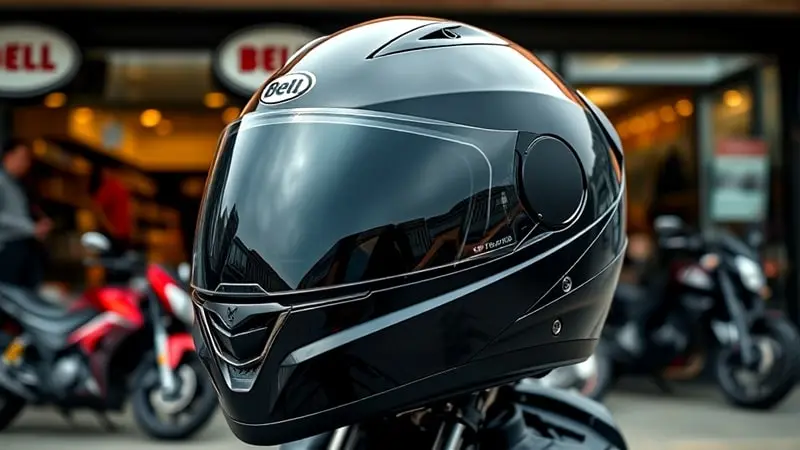
The Bell SRT helmet has a ventilation system that aims to keep riders cool, but it falls a bit short compared to some of its competitors.
Vent Placement and Operation
The SRT flip-up features a pretty standard array of vents:
- A single crown vent on top
- Two brow vents above the shield
- A large chin vent
All the vents are easy to operate with gloves on, thanks to large switches and sliders. I appreciate that I can open or close them on the fly without fiddling too much.
Airflow Performance
In practice, though, the vents don’t seem to flow as much air as I’d like[3][7]. Even with all the vents fully open, I don’t feel a ton of cooling airflow coming through.
The brow vents are the most effective at directing some air onto my forehead. But the chin vent mainly just shoots air onto the back of the shield rather than my face.
I often find myself cracking open the shield for extra airflow, even in mild temperatures around 70°F[3]. I can only imagine how stuffy it might get in hot summer weather.
Some other lids, like the AGV Sportmodular Carbon or Nolan N100-5, perform noticeably better in this regard.
The lack of airflow is one of the biggest drawbacks of the SRT modular, based on my experience and comments from other riders on forums.
Anti-Fog Performance
As for preventing shield fogging, the SRT flip up does an okay job. The Panovision shield from the factory has good anti-fog properties. The chin vent helps to clear away fog by directing air onto the shield.
But since overall airflow is mediocre, it can still fog up if you’re breathing heavily at a stop, especially in cold or humid conditions. Adding a Pinlock insert is probably a good idea for winter riding or if you’re prone to fogging.
So, in summary, the SRT has a pretty basic ventilation system that works decently but leaves room for improvement, especially in terms of keeping you cool in hot weather. Cracking the shield is often the best solution.
Noise Levels
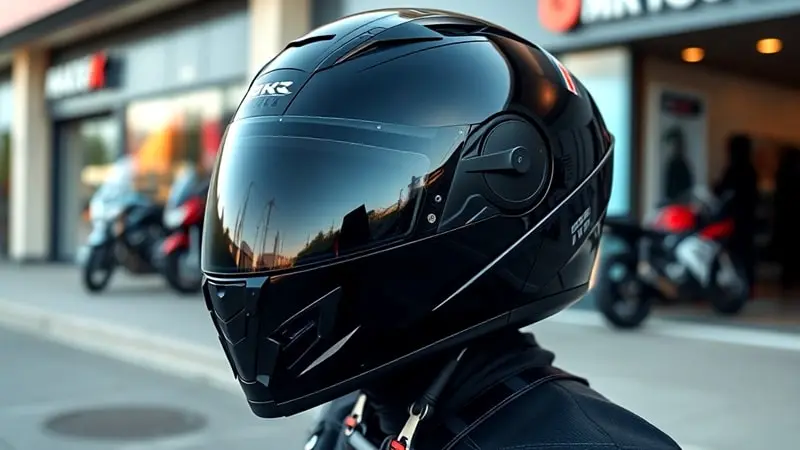
The Bell SRT struggles with wind noise, especially at highway speeds, making it one of the noisier lids I’ve tested.
Noticeable Wind Roar
Even with the vents closed, I experience a prominent low-frequency wind roar inside the SRT when riding at speeds above 55 mph.
The noise is present whether I’m behind a windshield or in direct airflow. Cracking open the face shield seems to make little difference.
Earplugs are a must for longer rides to prevent fatigue from the constant drone. Without plugs, I find myself needing to stop for breaks more often just to give my ears a rest from the assault.
Subpar Noise Reduction
The SRT modular’s noise reduction capabilities fall short compared to class-leading modular helmets like the Shoei Neotec 2 or Schuberth C4 Pro.
While not silent, those premium lids do a noticeably better job of hushing wind roar thanks to more advanced aerodynamics and thicker padding.
Even compared to more budget-friendly modulars like the Sedici Sistema II or HJC RPHA 90, I find the SRT flip-up to be a few decibels louder on average. The difference is most apparent on naked bikes or behind short windscreens that leave your head exposed.
Noise-Related Drawbacks
On forums, some SRT owners have complained about the helmet’s noisiness hampering their ability to hear Bluetooth headsets clearly, forcing them to max out the volume. Others have reported more fatigue on long rides due to the lack of quiet.
The small, ineffective chin curtain is partly to blame, as it fails to block air from rushing up into the helmet from below.
The minimalist shell design, while stylish, also lacks the more aggressive lines and spoilers of quieter helmets that help manage airflow.
So, while I love the SRT’s comfort, versatility, and value, I can’t ignore its subpar noise reduction. It’s the helmet’s most glaring flaw. Potential buyers should be aware that they’re trading some quietness for the SRT’s other strong points.
Earplugs are an absolute necessity on any longer trips. And if you prioritize a serene riding experience above all else, you may want to consider spending more for a premium modular lid built to hush noise.
Safety Ratings and Certifications
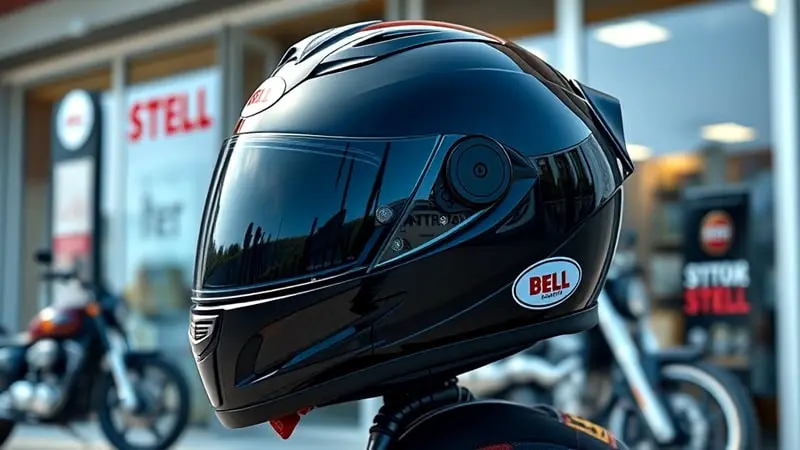
The Bell SRT helmet has received some key safety certifications but falls short of the highest standards in the industry.
DOT and ECE Certified
The SRT is both DOT (Department of Transportation) and ECE 22.05 certified. This means it meets the minimum legal safety requirements to be sold in the US and Europe.
DOT testing includes impact absorption, penetration resistance, and peripheral vision, while ECE also tests factors like shell strength and chin strap durability.
However, the SRT lacks the more stringent Snell certification that the regular SRT full-face model has. Snell standards are voluntary but more rigorous than DOT or ECE, with tougher impact resistance and penetration tests.
No Snell Rating for Modular Version
Interestingly, while the standard Bell SRT full-face is Snell M2015 certified, the modular version with the flip-up chin bar is not Snell-rated.
This seems to be a common pattern, where the flip-up design makes it harder to achieve Snell certification, possibly due to the chin bar hinge creating a potential weak point.
I think Bell likely added some extra bulk to the SRT shell to beef it up for DOT/ECE but couldn’t quite make the cut for Snell without compromising on weight and size. Most modular helmets on the market are not Snell-certified for this reason.
How It Compares
So, while the SRT meets basic DOT and ECE safety requirements, it doesn’t have the absolute top-tier Snell rating you’ll find on some other premium modular lids like the Shoei Neotec II[9]. The lack of a Snell sticker may turn off some safety-conscious riders.
That said, I believe the SRT flip-up, with its reinforced fiberglass composite shell[1], still provides very solid protection despite falling just short of Snell standards.
The DOT/ECE certifications are nothing to sneeze at. Avoiding the Snell penetration test arguably allows for a softer, more impact-absorbing shell.
At its $350 price point, the SRT flip-up delivers a lot of bang for your buck in terms of safety. It’s a reliable, protective modular option for riders who don’t need the absolute peak safety ratings and want to save a few hundred bucks compared to ultra-premium Snell-rated helmets.
Long-Term Durability

The Bell SRT holds up well over time, with most owners reporting good durability after extended use. However, there are a few common wear points to watch out for.
Sturdy Shell and Reliable Mechanisms
The SRT’s robust fiberglass composite shell resists daily knocks and bumps admirably. I haven’t seen any complaints of shell cracking or delamination, even after years of regular use.
The flip-up chin bar mechanism also proves reliable, with the locking system staying secure and the hinge showing little sign of loosening or excess play over time. The button release continues to work smoothly.
Interior Padding Longevity
Where some helmets’ interior padding packs out and deteriorates quickly, the SRTs generally maintain their shape and comfort. The moisture-wicking liner holds up to sweat and regular washing without falling apart.
After a year or two of heavy use, you may notice some flattening of the cheek pads and crown padding, but this seems to be par for the course with most helmets. Replacement pads are available if needed.
Typical Weak Points
As with many modular helmets, the chin bar seal is a potential failure point. Some users report the seal losing its tight fit against the eyeport gasket over time, allowing a bit more wind noise. Careful handling of the chin bar can mitigate this.
The clear face shield also tends to pick up scratches and hazing with extended use, particularly if you frequently ride in dusty or sandy conditions.
Using a helmet bag for storage and regular cleaning can prolong the shield’s clarity. Thankfully, shields are easily replaceable.
5-Year Warranty
Bell backs the SRT with a generous 5-year warranty, covering any defects in materials or workmanship. This is a strong vote of confidence in the helmet’s durability. I always register my Bell helmets to take advantage of this warranty, though I’ve rarely needed it.
While no helmet is invincible, I believe the SRT is engineered to last and handle the rigors of frequent riding.
With proper care, it should provide trustworthy protection for many riding seasons. Just keep an eye on those common wear points and replace the helmet after any significant impact.
Compatibility with Bluetooth Communication Systems
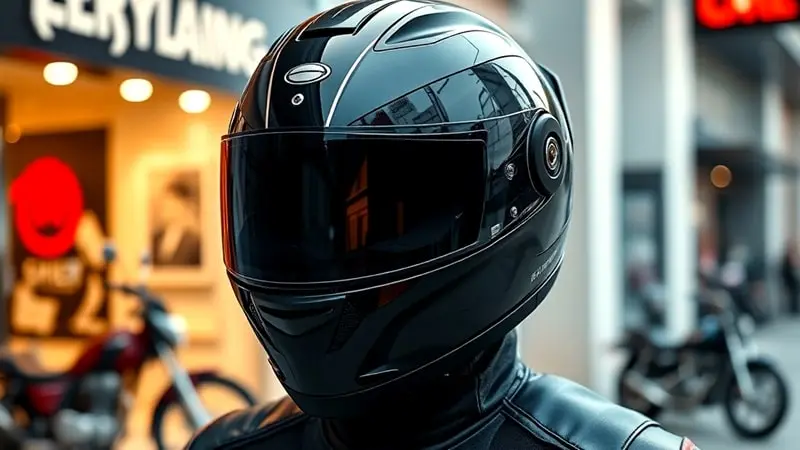
The Bell SRT flip-up is designed with Bluetooth communicator compatibility in mind, making it easy to install the most popular comm systems. However, the helmet’s design presents a few potential challenges for certain units.
Recessed Speaker Pockets
The SRT comes with recessed speaker pockets in the EPS liner, which is a great feature for accommodating Bluetooth speakers. The pockets allow you to cleanly install the speakers without creating pressure points or discomfort.
I found the pockets spacious enough to fit larger speakers from systems like the Cardo PackTalk or Sena 50S. The speaker placement also lines up well with my ears for optimal audio clarity.
Accommodating the Bluetooth Module
The SRT falls a bit short in providing a good spot to mount the main Bluetooth module. The sun visor slider on the lower left side takes up the prime real estate where most riders prefer to stick their comm unit.
You can still mount the module just behind the slider, but it’s a tight fit, especially for bulkier units. Slimmer modules like the Cardo Spirit or Sena 3S tend to work best. Alternatively, you can mount on the right side, but that’s less than ideal for most right-handed riders.
Challenges with Certain Units
Some riders on forums have reported issues getting a clean install with specific Bluetooth units on the SRT modular:
- The Sena 20S EVO apparently doesn’t mate well with the helmet’s gasket, causing wind noise leakage.
- The Cardo Freecom 4+ module may interfere with the helmet’s chin bar mechanism when mounted on the left side.
These challenges aren’t necessarily dealbreakers, but they’re worth considering when choosing a communicator for your SRT flip-up. Opting for low-profile units and taking extra care when mounting can help ensure a good fit.
Wired vs. Wireless Microphones
If you frequently ride with the chin bar flipped up, I recommend using a wired boom microphone instead of the standard wired mic.
The boom mic will stay in front of your mouth when you raise the chin bar, allowing you to keep communicating.
Wireless mics are another option, but they tend to pick up more wind noise when the chin bar is up. Sticking with a wired boom mic is usually the best bet for modular helmets like the SRT.
So, while the Bell SRT isn’t perfect for every Bluetooth setup, it’s still a very communicator-friendly helmet overall.
The recessed speaker pockets and accommodating interior make it easy to install the most popular units with a bit of care and creativity.
Features & Functions
The SRT’s defining highlight is versatility. Its design converts between full-face and open-face configurations within seconds. Yet it doesn’t sacrifice key features for flip-up practicality.
It employs Bell’s excellent Panovision face shield system, maximizing visual clarity. The cutaway window design offers an expansive field of view for scanning the road ahead – handy when head checking or transitioning lines mid-corner.
Sun Visor
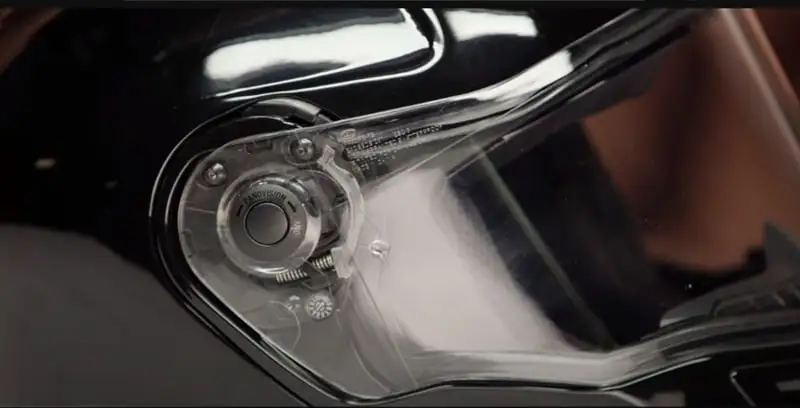
An optically correct drop-down sun visor is on board, too – a must for dealing with variable light conditions.
It seals against the elements when lowered, and the actuation slider is thoughtfully placed on the left side, avoiding interference with your throttle hand.
The main shield itself uses Bell’s tried-and-tested Velocity lock system. Tool-free removal and installation take moments while offering excellent optical acuity free from distortion.
Chin Bar
The operation of the chin bar itself is smooth and intuitive. A centrally-located lever allows an ambidextrous opening secured by steel latches at the chin and crown.
The city position is perfect for toll booths and fuel stops, while airflow in the cracked setting helps to prevent lens fogging.
Pros
- Lightweight fiberglass composite construction
- Race-oriented aerodynamic profile
- Expansive field of view from Panovision shield
- Optically-correct drop-down sun visor
- Superb balance and noise management
- Good ventilation from multiple intake and exhaust vents
- Accommodates Bluetooth headsets
Cons
- Chin curtain can be easily dislodged when opening the face shield
- At 3.14lbs, it sits at the heavier end of the modular scale
- More airflow directed onto the face would be welcome
Interior

The Bell SRT helmet’s interior provides a comfortable, customizable fit with some handy features for eyeglass wearers and Bluetooth communicator users. However, the liner’s noise reduction properties leave a bit to be desired.
Removable, Washable Comfort Liner
I really like the plush, moisture-wicking fabric Bell uses for the SRT’s comfort liner and cheek pads. It feels soft against my skin and does a good job of keeping my head dry on hot days.
The whole liner is also removable and washable, which is a must-have for me to keep helmet funk at bay.
The antibacterial treatment on the fabric is a nice touch for odor resistance. And I appreciate that Bell includes two sets of cheek pads in different thicknesses to let you dial in a personalized fit.
Eyeglass-Friendly EPS
As a bespectacled rider, I’m happy to report that the SRT flip-up accommodates my eyeglasses with ease. There are molded channels in the EPS liner that prevent the temples from digging into the sides of my head. I can wear my glasses for hours without any discomfort or pressure points.
The generously sized eye port also provides ample room for frames without touching or interfering with the helmet. Even my largest pair of sunglasses fits comfortably under the visor.
Recessed Speaker Pockets
Another interior strong point is the speaker pockets built into the EPS liner. They’re perfectly positioned to align speakers with my ears for optimal audio quality.
The pockets are also deep enough to fit larger 45mm speakers from popular Bluetooth communicators like the Cardo PackTalk and Sena 50S.
I had no trouble cleanly routing the wires for my Cardo communicator thanks to interior channels molded into the EPS.
The boom microphone also tucks neatly into the chin bar. It’s clear Bell designed the SRT with Bluetooth integration in mind.
Noise Reduction Falls Short
Unfortunately, the SRT interior padding doesn’t block out wind and road noise as effectively as I’d hoped. Even with the vents closed, I experience a prominent low-frequency wind roar at highway speeds. The helmet isn’t deafening, but it’s certainly no whisper-quiet touring lid.
Some owners on forums have complained about excessive noise levels hampering their ability to hear Bluetooth audio and intercom at speed.
Earplugs are a must for longer rides. Filling the speaker pockets with memory foam can help reduce noise slightly if you don’t use a communicator.
So, while I’m impressed with the SRT’s comfort, eyeglass friendliness, and Bluetooth integration, I do wish Bell had used denser, more sound-absorbent padding to hush more of the wind noise. It’s the helmet’s only notable weakness in an otherwise excellent interior.
FAQs
How does the SRT improve on the previous Bell Revolver?
The SRT gets a lighter fiberglass shell instead of the Revolver’s polycarbonate unit. It shaves almost a half pound of weight while improving impact protection. The race-oriented design offers sportier ergonomics and aerodynamics, too.
Would the Bell SRT work well for adventure touring?
The SRT’s lightweight shell, superior optics, and enhanced venting capabilities make it suitable for ADV use.
The peak helps shield sun glare during long highway stints, while the modular design is perfect for conversing during fuel stops. I’d be confident wearing it on serious long-haul trips.
How does noise isolation compare to premium race helmets from Arai or Shoei?
The SRT holds up respectably to top-shelf race lids for noise reduction thanks to effective neck and chin seals.
Some turbulence is noticeable at highway speeds, but it avoids excessive buffeting. Earplugs help smooth out wind rush – overall, the SRT finds an excellent balance.
Our Verdict
Bell enters a new category with the sporty SRT modular, combining versatility, comfort, and performance. Build quality impresses across the board thanks to premium materials and race-tuned ergonomics.
It demands consideration for riders seeking a lightweight flip-up accommodating both touring and aggressive canyon rides.
Priced very competitively against rivals, the Bell SRT punches above its class. There are minor niggles around the chin curtain durability and limited customization of airflow. However, the plush interior, expansive optics, and noise-reduction make it a phenomenal four-season lid.
After hundreds of miles on varied roads and surfaces, I award top marks to the game-changing Bell SRT. It melds modular practicality with uncompromised protection and style. Versatility doesn’t get better than this.
So, have you tried Bell’s new high-performance modular? How do you rate it? Let me know your experiences below!
Previous Article:
Next Article:
Sources: IMPACT TESTS (1)

